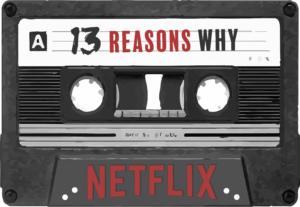“13 Reasons Why” features controversial depiction of teen-suicide
Alyssa Gilroy
Staff Writer

The newly released Netflix series “Thirteen Reasons Why,” released on March 31, has skyrocketed in popularity. The show tackles high school suicide, depression and sexual assault.
The show consists of 13 main characters. Hannah Baker (Katherine Langford) and Clay Jensen (Dylan Minnette) are the main focus of the current (first) season. The end of each episode is revealed at the beginning of the series.
Hannah Baker commits suicide, leaving behind 13 reasons for her ending her life on separate cassette tapes.
She leaves the tapes behind for Clay Jensen and 12 others, detailing why she took her own life. There are 13 tapes and 13 episodes in the season. Each tape describes a different classmate’s role in her suicide.
Each person is instructed to listen to the 13 tapes before passing them along to the next listener. Viewers watch as Jensen listen to the tapes, with his listening taking longer than the others’. By the end, viewers can events together chronologically and figure out what led to Hannah’s suicide.
Netflix productions commonly exceed viewers expectations and I believe this outstanding show does the same. However, there are obvious pros and cons associated with the show’s reception, particularly concerning the social issues addressed throughout the season.
Suicide, sexual assault and depression are central themes within the narrative. Even with the centrality of the aforementioned topics, the TV production manages to display said themes more frequently than the written source material.
The portrayal and execution of the issues has sparked up conversation among viewers, with some health care professionals suggesting it romanticizes suicide while displaying improper coping skills and a distorted view of mental health issues.
The show also sets up unrealistic expectations. In the show, it is revealed in the end that those who abused Baker might receive punishment for their wrongdoings. In reality, that does not always happen.
Baker also fails to talk with her parents about her problems. Hannah’s parents loved her, but she never went to them for any type of help. She’s alive one morning talking with them in their store and dead the same afternoon.
Anyone considering suicide should talk to their parents and friends. They are willing to listen and anyone considering suicide should find help.
Some voices in the media argue that the show is making students self-harm, but students are firing back—explaining that this has always been an issue. The topic is being publicized through the show.
The show excels at presenting transitions to past and present and the soundtrack complements its intended mood. The show is also Langford’s breakout role with a heartbreakingly well played Baker.
This series will make you cry. It made me cry and the story is especially powerful in the last two episodes which feature much needed warnings for potential viewers.
Whenever I recommend this show to others, I warn them about the last two episodes and how hard they are to watch. Watching Baker’s parents react to their only daughter’s suicide is especially heartbreaking due to Langford’s performance.
The impact of this series goes beyond the delivery of praiseworthy performances. The social issues addressed in the show are being discussed more than ever in part due to its rising popularity.
There are people out there who relate to Baker in some way and learned from the series. The series definitely keeps you wanting to watch more, so prepare to binge-watch.
The series was adapted from Jay Asher’s novel by the same name published in 2007. The series was produced by Netflix and produced by actress and singer-songwriter, Selena Gomez.
